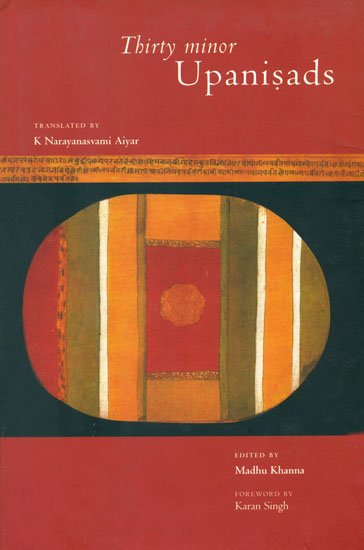Thirty minor Upanishads
by K. Narayanasvami Aiyar | 1914 | 95,228 words
This book contains the English translation of thirty minor Upanishads.—Fourteen belonging to Vedanta, two are categorised as Physiological, three are Mantra, two are Sannyasa and the remaining nine are categorised as Yoga-Upanishads. These Upanishads are properly defined as the Aranya-portion of the Vedas (most ancient Hindu scriptures) and are so-...
Paingala Upanishad of Shukla-Yajurveda, Chapter III
Then Paiṅgala asked Yājñavalkya to offer an exposition on the mahāvākyas (sacred sentences of the Vedas). To which Yājñavalkya replied: "One should scrutinise (the sacred sentences), Tattvamasi (That art thou), Tvamtadasi (Thou art That), Twambrahmasi (Thou art Brahman) and Ahambrahmāsmi (I am Brahman). The word 'Tat' denotes the cause of the universe that is variegated beyond perception, has the characteristics of omniscience, has Māyā as His vehicle and has the attributes of Saccidānanda. It is He that is the basis of the notion 'I' which has the differentiated knowledge produced by antaḥkaraṇa; and it is He that is denoted by the word 'Twam' (Thou). That is the undifferentiated Brahman which remains as the aim (or meaning) of the words Tat and Tvam after freeing itself from Māyā and Avidyā which are respectively the vehicles of Paramātmā and Jīvātmā. The inquiry into the real significance of the sentences Tattvamasi and Ahambrahmāsmi forms (what is called) śravaṇa (hearing—the first stage of inquiry). To inquire in solitude into the significance of śravaṇa is manana. The concentration of the mind with one-pointedness upon that which should be sought after by śravaṇa and manana is nididhyāsana. Samādhi is that state in which citta having given up (the conception of the difference of) the meditator and the meditation, becomes of the form of the meditated like a lamp in a place without wind. Then arise the modifications pertaining to Ātmā. Such (modifications) cannot be known; but they can only be inferred through memory (of the samādhi state). The myriads of karmas committed in this beginningless cycle of rebirths are annihilated only through them. Through proficiency in practice, the current of nectar[1] always rains down in diverse ways. Therefore those who know Yoga call this samādhi, dharma-megha (cloud). Through these (modifications of Ātmā), the collection of affinities is absorbed without any remainder whatever. When the accumulated good and bad karmas are wholly destroyed, these sentences (Tattvamasi and Ahambrahmāsmi), like the myrobalan in the palm of the hand, bring him face to face with the ultimate Reality, though It was before invisible. Then he becomes a Jīvanmukta.
"Īśvara wished to produce non-quintuplication (or involution) in the fivefold differentiated elements. Having drawn into their cause Brahma's egg and its effects of worlds, and mixed together the subtle organs of sense and action and the four internal organs and dissolved all things composed of the elements into their cause, the five elements, He then caused pṛthivī to merge into water, water into agni, agni into vāyu, and vāyu into ākāś, ākāś into ahaṅkāra, akaṅkāra into mahat, mahat into avyakta, and avyakta into Puruṣa in regular order. Virat, Hiraṇyagarbha and Īśvara being freed from the vehicle of Māyā, are absorbed into Paramātmā. This gross body composed of the five differentiated elements and obtained through accumulated karma, is merged into its subtle state of non-quintuplicated elements, through the extinction of (bad) karma and increase of good karma, then attains its kāraṇa (causal) state and (finally) is absorbed into its cause, (viz.,) Kūtastha-Pratyagātma. Viśva and Taijasa and Prājña, their upādhi (of avidyā) having become extinct, are absorbed in Pratyagātmā. This sphere (of universe) being burnt up by the fire of jñāna is absorbed along with its cause into Paramātmā. Therefore a Brāhmaṇa should be careful and always meditate upon the identity of Tat and Tvam. Then Ātmā shines, like the sun freed from the (obscuration of the) clouds. One should meditate upon Ātmā in the midst (of the body) like a lamp within a jar.
"Ātmā, the Kūtastha, should be meditated upon as being of the size of a thumb, as being of the nature of the jyotis (light) without smoke, as being within, illuminating all and as being indestructible. That Muni (sage) who meditates (upon Ātmā always) until sleep or death comes upon him passes into the state of (Jīvanmukti) emancipation like the immovable state of the wind. Then there remains that One (Brahman) without sound, touch, free from destruction, without taste or odour, which is eternal, which is without beginning or end, which is beyond, the Tattva of Mahat, and which is permanent and without stain or disease."
